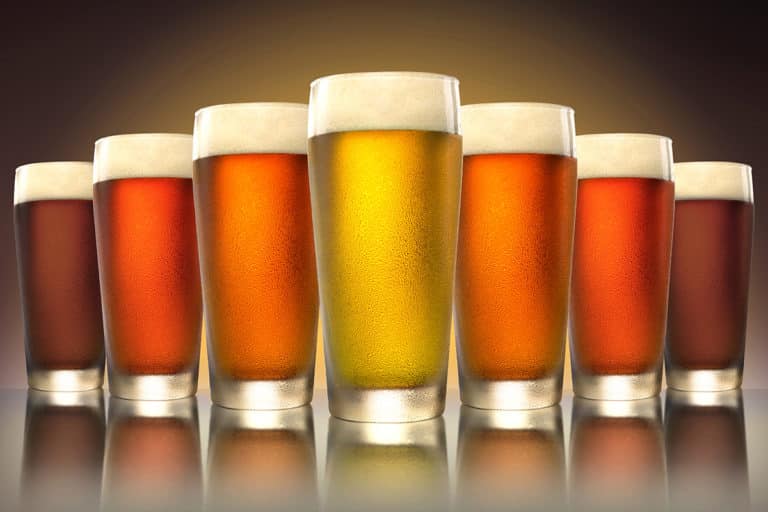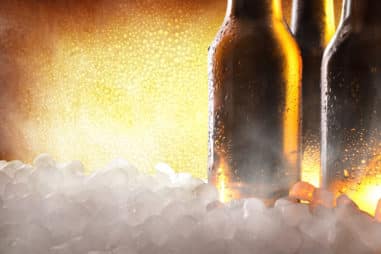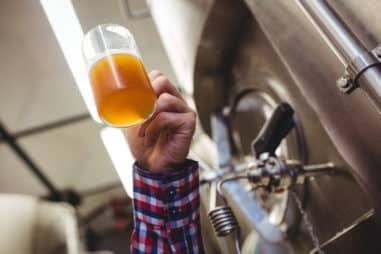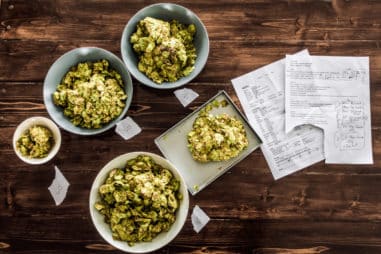Measuring SRM is attainable by everyone. It can be as complicated as using fancy apparatus, or as simple as comparing two to three of your favorite beers. This article explores SRM so you can get a step closer to creating your signature brew.
What Does SRM in Beer Stand for?
SRM is the abbreviation of Standard Reference Method. It is North America’s gold standard for measuring the color of your beer.
It involves the scientific process of measuring the change of a light’s wavelength after it crosses one centimeter of your favorite beer. This wavelength corresponds to blue-violet light.
So, in layman’s terms, you would flash a blue-violet light through your beer, then record the loss in value. This value is then slapped into a formula to get the SRM.
Is SRM and Lovibond the Same?
The Lovibond method was the original method used for measuring beer color. It heavily relied on the vision and perception of the human operator.
SRM is more of a derivative of the Lovibond method. It cuts the subjectivity out of taking measurements by relying on instrumentation.
You can refer to the table for the notable differences between the two.
| Lovibond | SRM | |
| Year of Use | Invented in 1885 by Joseph Williams Lovibond. | Adopted in the 1950s by the American Society of Brewing Chemists. |
| Method | Compare a sample beer to colored glass discs.
These discs match up to known values in the Lovibond scale. |
Measuring the dimming of light after crossing the sample beer.
Multiply the value by a constant to get the SRM. |
| Equipment | Glass discs and colorimeter. | Spectrophotometer. |
| Result Bias | Human visual assessment. | Instrument output. |
Is SRM Better than Lovibond?
The SRM method is mostly preferred over Lovibond for the objectivity of the process. If you use SRM, you will have an easier time establishing the color of your product. And you will be able to avoid misrepresentations of color when marketing.
Be that as it may, the Lovibond scale is still used to make beer color estimates. It is also widely used in the description of grain colors used in beers.
How to Calculate SRM in Beer
If you rolled your eyes after reading the word “calculate,” you can try online brewing software. But if you are a hardcore brewer and math fanatic, this is for you:
- Calculate the Malt Color Units (MCU):
- MCU is equal to the Grain Weight (in pounds) multiplied by the Color of the Grain (in degrees Lovibond or °L) divided by the Final Volume (in US Gallons).
- MCU = (Grain Weight, lbs) × (Color of grain, °L)
÷ [Final Volume, US gal] - For multiple grain combinations, sum all of their individual MCUs to get the total MCU.
- Calculate the SRM:
- The SRM is equal to 1.4922 multiplied by the total MCU raised to the power of 0.6859.
- SRM = 1.4922 × MCUTOTAL ^ 0.6859
What Influences the Color?
Calculating SRM is all well and good, but here is what you can do if you have a target color for your brew:
- Selecting Malts: Select your base grains and calculate what you may need to reach your target SRM.
- Roasting: The more roasted your malt is, the darker your brew. You can try varying your roast duration and temperatures to get the perfect shade.
- Regulating pH levels: Higher pH levels in water link to darker beer. This is applicable in all stages of brewing.
- Brewing: Brewing for longer allows for extracting more of the color in your mash. It also caramelizes your mash, making them darker.
- Fermenting: The temperatures and yeast you use have a lot of impact on the color.
- Aging: If you decide to use wooden vessels, they will leech some of their colors on your product.
- Filtering: The particles in your beer reflect light in certain ways.
What Are the Limitations of SRM?
The SRM method uses a single wavelength of light to get the corresponding SRM value. The reality is, light is made of a spectrum of hues. Because of this, similarly colored beers are not easy to differentiate. Also, your color prediction might not match the reference colors you printed out.
It all boils down to setting a reasonable expectation for the detail of your color estimates. And, a lot of hands-on experience will give you better intuition on how things work. Note that even the big boy brewers use coloring agents and batch mixing to reach specific SRMs.
What Is the Range of the SRM Scale for Beer Color?
The common range of the SRM scale is 1 to 40+. It feels weird to see a boundary of “40+” on a scale. It actually speaks to the limitation of your eye to discern differences in the shades of black. Most people even argue that it is pointless to scale black, seriously.
SRM Beer Scale
For you to get a macroscopic view of the SRM scale, check this table out:
| SRM VALUES | EXAMPLE |
| 2 | Pale lager, Witbier, Pilsener, Berliner Weisse |
| 3 | Maibock, Blonde Ale |
| 4 | Weissbier |
| 6 | American Pale Ale, India Pale Ale |
| 8 | Weissbier, Saison |
| 10 | English Bitter, ESB |
| 13 | Biere de Garde, Double IPA |
| 17 | Dark lager, Vienna lager, Marzen, Amber Ale |
| 20 | Brown Ale, Bock, Dunkel, Dunkelweizen |
| 24 | Irish Dry Stout, Doppelbock, Porter |
| 29 | Stout |
| 35 | Foreign Stout, Baltic Porter |
| 40+ | Imperial Stout |
What SRM Is Orange?
To achieve a bright and happy orange color, you would need an SRM of 6 to 9. Descriptions of this color go from middling gold to light reddish amber. These beers would give a white to off-white colored foam head.
An example of this would be an American IPA. Its color would vary from orange with a coppery tint to burnt gold.
What SRM Is Red Ale Beer?
Red Ale beers fall into the bucket of SRM 9 to 18. You could visualize these colors in terms of being scarlet, vermillion, or ruby red. These beers would give an off-white to tan colored foam head.
A perfect example is Irish-style Red Ale. Its red comes from roasted barley.
What Is the SRM of Wheat Beer?
The Wheat Beer class has SRM values all over the chart. There are pale and dark versions of wheat beers. Pale wheat beers have an SRM of 2 to 6. Their darker brethren have an SRM of 6 to 25.
You could imagine the pale wheat beers as very pale straw, sun-soaked straw, or light amber. Dark wheat beers appear like light copper, mahogany brown, or dark ruby brown.
What SRM Is Black?
To get a somber, inky, or ebony color, SRM 40+ is the magic number. You could describe some blends as looking like motor oil. They usually have a deep tan to a dark mocha foam head.
What Is the Highest SRM Beer?
The Russian Imperial Stout is the most common beer that resides in the 40+ range. The SRM scale is usually capped at a value of 40+. Even expert beer judges agree that there is only so much your eye can do when it comes to assessing “blackness.” Nevertheless, there are beers that substantially exceed SRM 40.
Just because you can make a super black beer does not mean you should. Darker beers are normally associated with stronger and potentially charred flavors.
How to Measure the Color of Your Brew?
You can determine the color of your brew even without a spectrophotometer. You do not even need to send your sample to a beer laboratory. If you want to do it yourself, here is a method you can follow:
- Pour two inches (5 cm) of fresh beer into a clear glass or plastic cup.
- Pour fast enough to foam.
- Swirl the beer until the gas bubbles have subsided.
- Place the cup on top of a pure white sheet of paper or cloth.
- You should use daylight or a lamp approximating daylight (6500K bulbs to be specific).
- Look down, through the beer, at the white background.
- Place your color standard beside the beer to view them at the same time.
- You can buy color cards as a standard reference.
- You can buy beers that have extensive documentation on their SRM values.
- Find the closest match. If the color is between two reference colors, you can use the middle value as a rough estimate.







